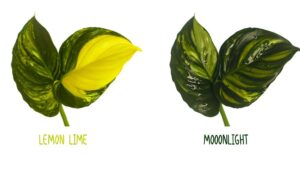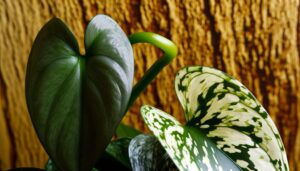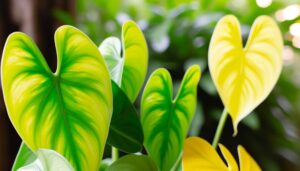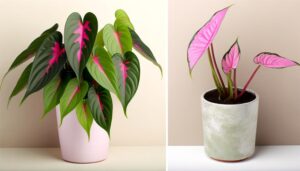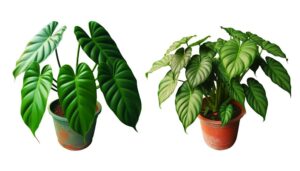Philodendron Xanadu Vs Monstera
Philodendron Xanadu and Monstera, both from tropical South America and the Araceae family, present distinct botanical characteristics. Xanadu's compact, deeply lobed, symmetrical leaves suit smaller spaces, while Monstera's large, fenestrated leaves are ideal for larger areas.
Xanadu exhibits a clumping growth habit, thriving in bright, indirect light. In contrast, Monstera is a hemiepiphytic climber, flourishing best in moderate to high indirect light.
Both require well-draining, nutrient-rich soil and ideal humidity levels (60-80%). Their care also involves mindful watering to prevent root rot.
For further insights on their maintenance and best uses, continue on.
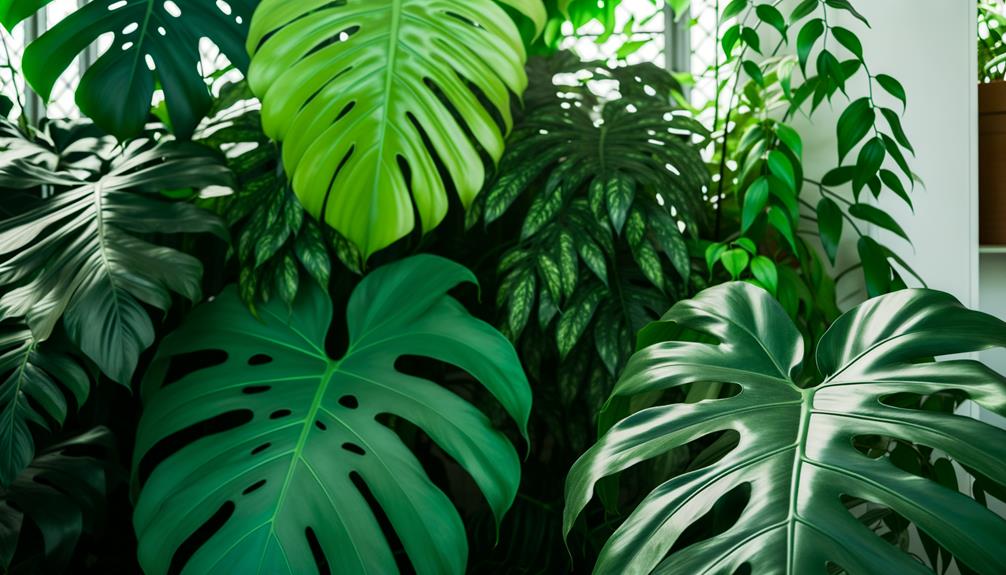
Key Takeaways
- Philodendron Xanadu has deeply lobed, compact leaves, while Monstera features large, fenestrated leaves with irregular holes.
- Xanadu grows in a clumping, spread-out manner; Monstera climbs with aerial roots.
- Xanadu thrives in bright, indirect light, whereas Monstera prefers moderate to high indirect light.
- Both plants need well-draining soil rich in organic matter but Monstera prefers a chunkier, aerated substrate.
- Philodendron Xanadu prefers temperatures between 65°F to 80°F, while Monstera thrives in 70°F to 85°F.
Origin and Background
Originating from the tropical regions of South America, Philodendron Xanadu and Monstera both belong to the Araceae family, yet they exhibit distinct evolutionary traits and ecological niches.
Philodendron Xanadu thrives in understorey environments, adapting to lower light levels and humid conditions, which makes it a great choice for indoor cultivation.
In contrast, Monstera species, such as Monstera deliciosa, are hemiepiphytic climbers, often found scaling trees in rainforest canopies to access higher light.
Their differing growth habits reflect their unique adaptations; Xanadu's compact growth suits confined spaces, while Monstera's vining nature requires structural support.
Understanding these origins and ecological preferences aids in replicating their natural habitats, ensuring ideal growth and health in both domestic and commercial horticultural settings.
Appearance and Foliage
When comparing the Philodendron Xanadu and Monstera, one must consider the distinct differences in leaf morphology, pigmentation, and surface characteristics.
Philodendron Xanadu exhibits deeply lobed, compact leaves with a glossy, dark green hue, whereas Monstera's foliage is characterized by large, fenestrated leaves that sport a lighter, matte green finish.
These variances not only influence aesthetic appeal but also impact light absorption and water retention, important factors for best plant care.
Leaf Shape Differences
The leaf morphology of Philodendron Xanadu and Monstera is distinctly different, with Philodendron Xanadu exhibiting deeply lobed, symmetrical leaves, while Monstera presents large, fenestrated foliage with characteristic perforations.
Philodendron Xanadu leaves are typically smaller, averaging 18 inches in length, and possess a uniform split pattern that contributes to their orderly appearance. In contrast, Monstera leaves can grow up to 3 feet, displaying irregularly spaced holes and slits, a result of natural adaptation for light penetration and wind resistance.
Such morphological differences require different care considerations; for instance, Monstera's larger leaf surface area necessitates more frequent dusting and potential structural support. Understanding these distinctions aids in providing ideal growth conditions and enhancing ornamental value.
Color and Texture
Philodendron Xanadu exhibits a rich, deep green hue with a glossy texture, whereas Monstera's foliage tends to be a lighter shade of green with a more matte finish, providing distinct visual contrasts in ornamental horticulture.
These textural differences are significant in landscape design and interior plant settings.
- Leaf Surface: Xanadu's glossy leaves reflect light, enhancing its vibrant appearance, while Monstera's matte surfaces offer a more subdued look.
- Color Variation: Monstera's foliage may display variegation, adding a unique aesthetic, unlike the uniform green of Xanadu.
- Tactile Experience: Xanadu leaves are smooth and firm, providing a tactilely pleasing feel, contrasting with Monstera's more leathery texture.
- Maintenance: The glossy surface of Xanadu's leaves repels dust more effectively, simplifying cleaning compared to Monstera's matte leaves.
Growth Patterns
Philodendron Xanadu exhibits a compact, clumping growth habit, contrasting with Monstera's characteristic climbing behavior facilitated by aerial roots.
Leaf development in Xanadu tends to be more symmetrical and uniform, while Monstera produces fenestrated leaves that adapt to varying light conditions by enlarging or splitting.
Understanding these growth patterns is essential for optimizing care, placement, and support structures within various interior environments.
Leaf Development Differences
In examining the leaf development differences between Philodendron Xanadu and Monstera, one must consider the distinct growth patterns that define each species.
Philodendron Xanadu leaves manifest a more compact and symmetrical arrangement, characterized by deeply lobed and glossy green foliage.
In contrast, Monstera leaves, particularly those of Monstera deliciosa, develop fenestrations—distinctive splits and perforations—enhancing their ornamental appeal. The developmental timeline and environmental responsiveness also diverge, with Monstera exhibiting a more dynamic adaptation to light intensity and humidity.
Understanding these differences aids in selecting the appropriate species for specific horticultural and decorative applications.
Climbing Vs. Spreading
Distinct growth patterns between Philodendron Xanadu and Monstera are further exemplified in their respective climbing and spreading tendencies. Philodendron Xanadu exhibits a compact, self-heading growth habit, spreading outward rather than upward. In contrast, Monstera, including Monstera deliciosa, displays a vining habit, utilizing aerial roots to climb supports. These differing growth patterns necessitate tailored care practices.
| Plant Type | Growth Habit | Support Needs |
|---|---|---|
| Philodendron Xanadu | Spreading, bushy | Minimal, ground cover |
| Monstera | Climbing, vining | Requires support structures |
| Xanadu Rooting | Terrestrial, clump-forming | Ground stability |
| Monstera Rooting | Aerial and terrestrial roots | Climbing anchors |
Understanding these growth behaviors is essential for optimizing the placement and structural support of these plants in both indoor and outdoor environments.
Light Adaptation Needs
Ideal light conditions are essential in promoting the unique growth patterns of both Philodendron Xanadu and Monstera, requiring customized light adaptation strategies to maximize their physiological development.
Philodendron Xanadu thrives in bright, indirect light, which replicates its natural understory habitat, promoting compact growth and robust foliage. It requires bright, indirect light to avoid leaf burn, but it can tolerate lower light, although this results in slower growth and smaller leaves.
Monstera, on the other hand, prefers filtered sunlight, stimulating its characteristic fenestrations and vining tendencies. It shows the best growth in east-facing windows with morning light. Direct sunlight can cause scorching, while too little light impedes fenestration.
Understanding these light needs ensures both species thrive in indoor environments.
Light Requirements
Philodendron Xanadu thrives in bright, indirect light. It requires an ideal photic environment involving filtered sunlight to mimic its native understory habitat, ensuring it avoids phototoxicity while maintaining vibrant foliage.
Monstera, on the other hand, can tolerate a range of light conditions, from low to bright indirect light. However, it performs best with moderate to high indirect light. With its epiphytic nature, Monstera exhibits greater flexibility, adapting well to both shaded conditions and stronger light levels.
Providing Monstera with abundant, diffused light promotes optimum foliar development and fenestration. For indoor cultivation, placing these plants near east or west-facing windows, supplemented by sheer curtains, can replicate their preferred conditions, fostering robust growth and maintaining their ornamental appeal.
Watering Needs
When addressing the hydration requirements of Philodendron Xanadu and Monstera, it is imperative to take into account their native environments, which dictate their respective moisture preferences and tolerance levels.
Philodendron Xanadu, originating from the tropical regions of Brazil, thrives in consistently moist but well-drained conditions.
Conversely, Monstera, native to the rainforests of Central America, prefers a more moderate watering schedule, allowing the soil to dry slightly between waterings.
Key considerations include:
- Philodendron Xanadu: Requires frequent watering to maintain moist soil without waterlogging.
- Monstera: Benefits from a balanced watering routine, with intervals of drying.
- Avoiding Overwatering: Critical for both species to prevent root rot.
- Humidity Levels: Maintaining high humidity is beneficial for both plants' health.
Soil Preferences
The soil preferences for Philodendron Xanadu and Monstera diverge based on their specific needs for ideal growth.
Philodendron Xanadu thrives in a well-draining soil mix rich in organic matter, ensuring moisture retention while preventing waterlogging.
Conversely, Monstera benefits from a chunky, aerated substrate incorporating components such as orchid bark and perlite to mimic its natural epiphytic environment, promoting root aeration and effective drainage.
Ideal Soil Mixes
Achieving ideal growth for both Philodendron Xanadu and Monstera requires a carefully balanced soil mix that provides sufficient aeration, moisture retention, and nutrient availability. For optimum results, the soil composition should be tailored to meet the specific needs of each plant.
A well-draining mix that incorporates organic matter and mineral components is essential. The following elements are recommended for an ideal soil mix:
- Peat Moss: Enhances moisture retention and provides a slightly acidic pH.
- Perlite: Improves soil aeration and drainage, preventing root rot.
- Orchid Bark: Adds structure and helps in maintaining an airy environment.
- Compost: Supplies essential nutrients and improves soil fertility.
Drainage and Aeration
Securing sufficient drainage and aeration in the soil is crucial for the healthy growth of both Philodendron Xanadu and Monstera, as it prevents waterlogging and promotes root oxygenation.
For Philodendron Xanadu, a well-draining mix incorporating perlite or coarse sand is necessary to avoid root rot.
Monstera, with its epiphytic nature, benefits from a blend containing orchid bark, peat, and perlite to mimic its native airy substrate.
Both species thrive in a medium that allows excess water to escape swiftly while maintaining moisture balance. Regularly checking the substrate for compaction and amending it as needed ensures sustained aeration.
Using pots with drainage holes further complements these soil preferences, fostering an ideal environment for root health and overall plant well-being.
Temperature Tolerance
Both Philodendron Xanadu and Monstera display specific temperature tolerances that are crucial for the most favorable growth and health. Philodendron Xanadu thrives in temperatures ranging from 65°F to 80°F, while Monstera prefers slightly warmer conditions between 70°F and 85°F.
Both species are sensitive to cold and should not be exposed to temperatures below 50°F. Sudden temperature fluctuations can cause stress, leading to leaf discoloration or drop.
- Philodendron Xanadu: Best range is 65°F to 80°F.
- Monstera: Preferred temperature falls between 70°F to 85°F.
- Cold Sensitivity: Avoid exposure below 50°F for both plants.
- Temperature Stability: Minimize sudden changes to prevent stress.
This precise temperature management guarantees robust growth and well-being for these tropical species.
Humidity Needs
In addition to temperature management, maintaining ideal humidity levels is necessary for the healthy growth of Philodendron Xanadu and Monstera. Both species thrive in environments with elevated humidity, typically within the range of 60-80%. Insufficient humidity can lead to desiccation of foliage and hindered growth. Utilizing a humidifier or periodically misting the leaves can effectively sustain the required moisture levels. Below is a comparative table detailing the humidity requirements for each plant:
| Plant | Best Humidity Range | Recommended Practices |
|---|---|---|
| Philodendron Xanadu | 60-80% | Use humidifier, mist leaves |
| Monstera | 60-80% | Use pebble trays, mist foliage |
| Common Symptoms | Brown leaf edges | Increase ambient humidity |
| Additional Tips | Group plants | Regularly check humidity levels |
Ensuring ideal humidity is essential for the health of these tropical plants.
Common Pests
Philodendron Xanadu and Monstera are susceptible to a variety of common pests that can impair their growth and health. Understanding these pests is essential for maintaining the vigor of these popular houseplants.
The most frequently encountered pests include:
- Spider Mites: These tiny arachnids cause stippling and yellowing of leaves, often leading to webbing.
- Mealybugs: Recognizable by their white, cotton-like appearance, they feed on plant sap, weakening the plant over time.
- Scale Insects: These pests attach themselves to stems and leaves, creating protective shells and excreting honeydew, which can invite mold.
- Aphids: These small, soft-bodied insects cluster on new growth and underside of leaves, causing distortion and stunted growth.
Regular inspection and prompt treatment are necessary to manage these pests effectively.
Maintenance and Pruning
Maintaining and pruning Philodendron Xanadu and Monstera involves strategic trimming to promote healthy growth, shape the plant, and remove any diseased or damaged foliage.
For Philodendron Xanadu, prune in the spring by cutting back leggy stems and removing yellowing leaves to maintain its compact form. Use sterilized pruning shears to prevent infection.
Monstera requires pruning to control its vigorous growth. Trim aerial roots and any overextended stems, focusing on nodes to encourage new shoots. Regularly inspect for pests and signs of disease, removing affected parts immediately.
Both plants benefit from the removal of older, less productive leaves to direct energy towards new growth. Proper pruning will guarantee robust and aesthetically pleasing plants, enhancing their longevity and essentiality.
Ideal Uses
When considering the ideal uses for Philodendron Xanadu and Monstera, it is essential to evaluate their unique growth habits and aesthetic attributes to determine the most suitable applications in both interior design and landscaping contexts.
Philodendron Xanadu, with its compact, bushy structure and deeply lobed leaves, excels as a ground cover or focal point in shaded garden beds.
Conversely, Monstera, known for its large, fenestrated leaves and climbing nature, is ideal for vertical spaces or as an indoor statement piece.
Understanding these characteristics allows for strategic placement to enhance aesthetic and functional value.
Conclusion
In comparing Philodendron xanadu and Monstera, both species exhibit unique botanical characteristics that enhance indoor environments.
While some may argue that their care requirements are too demanding, their distinct foliage and growth patterns offer significant aesthetic and psychological benefits.
Proper understanding and adherence to their specific light, water, and humidity needs will guarantee robust growth.
The maintenance efforts are minimal compared to the rewarding visual appeal and the air purification qualities they bring to any space.

